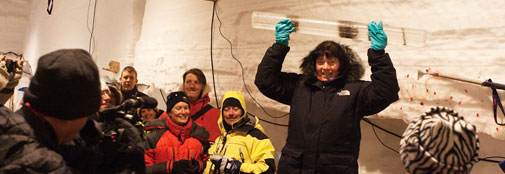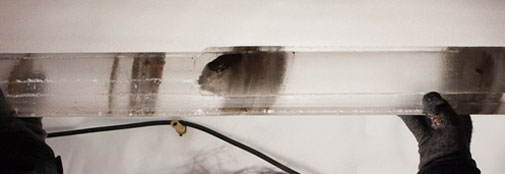Bedrock at NEEM reached on Tuesday 27, 2010!

Professor Dorthe Dahl-Jensen with the last icecore drilled at a depth of 2537,36 m
Bedrock has been reached Tuesday July 27 2010 at the deep ice core drilling site NEEM on the Greenland Ice Sheet at the depth 2537.36 m. The Eemian is the last interglacial period, when climate was warmer than today, and sea level 5 meters higher, and is our best analogue for future climate.
Scientists from 14 nations participated in NEEM, the most international ice core effort to date. After five years of work, ice from the warm interglacial Eemian period, 130.000 to 115.000 years before present and even older ice has been recovered. The last 2 m of ice above the bedrock contains rocks and other material that has not seen sunlight for hundreds of thousands of years. We expect the ice to be rich in DNA and pollen that can tell us about the plants that existed in Greenland before the site became covered with ice, perhaps as long as 3 million years ago.
More than 300 ice core researchers including many young scientists have been in the NEEM camp during the last years. The ambitious scientific program of the NEEM project involves science groups from 14 participating nations.
The abrupt climate changes are studied in detail by a suite of different measurements, including the stable water isotopes telling about temperature changes and moisture sources back in time, greenhouse gasses trapped in the ice and biological content that improves our understanding of the natural variability, feedbacks of the carbon and the biogenic cycle and very detailed chemical measurements resolving the annual variations of the climate.
Measurements made on site, meters below the snow surface in the science trench, go beyond what has ever been done at deep ice core camps before. State-of-the-art laser instruments for water isotopes and greenhouse gasses, online impurity measurements and advanced studies of ice crystals are among the impressive instruments at NEEM, one of the most inaccessible parts of the Greenland ice sheet.
The main goal of the NEEM project is to learn more about the warm Eemian climate period because it in many aspects can be seen to an analogue to the warming we will experience in the future. How reduced was the Greenland ice sheet 120.000 years ago when the global temperature was 2-3 deg C warmer than the present? And how much and how fast did the Greenland Ice Sheet contribute to sea level at that time? We expect that our findings will increase our knowledge on the future climate system and increase our ability to predict the speed and final height of sea level rise.
The progress in the drilling at NEEM can be followed in the dairy on www.neem.ku.dk where pictures from the camp also can be found.

The last 2 m of ice above the bedrock contains rocks and other material that has not seen sunlight for hundreds of thousands of years.
From the NEEM camp
Project Leader Dorthe Dahl-Jensen
